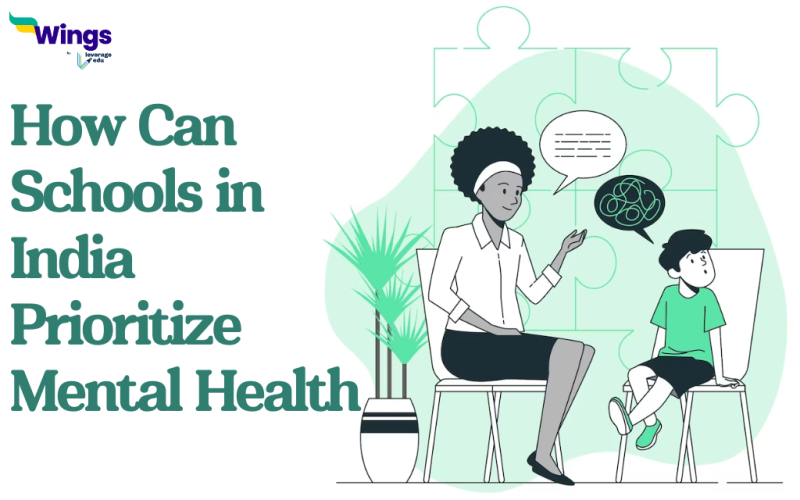India has a vast education system that caters to almost 450 million students, larger than any other country. While schools focus on providing quality education, the importance of mental health is often overlooked. The COVID-19 pandemic has highlighted the need for prioritizing mental health in schools as students faced unprecedented levels of depreciation in mental health conditions. Unfortunately, with increasing academic pressure and a highly competitive environment, students in India are more vulnerable to mental health issues than ever before.
Therefore, it is crucial for schools also to prioritize mental health from the age of adolescence itself, and create a safe and supportive environment for students to thrive academically and emotionally. In this context, this topic explores various ways in which schools in India can prioritize mental health and support the overall well-being of their students.

This Blog Includes:
- 10 Ways to Prioritize Mental Health Amongst Students in Indian Schools
- Listen and Understand Children’s Concerns
- Create a Safe and Supportive Environment
- Keep an Eye on the Child’s Behavioural Patterns
- Teach Coping Skills
- Open Communication for Students: Being Caring, Calm, and Honest
- Role of a Special Educator
- Address Bullying and Harassment
- Foster Positive Relationships
- Develop On-campus Counseling Service Team
10 Ways to Prioritize Mental Health Amongst Students in Indian Schools
Teachers have a very pivotal role to play when it comes to transitioning a student’s learning within his classroom to the life ahead. Keeping in consideration the need of the hour, we have listed 10 needed ways that should be highly prioritized while ensuring the emotional well-being of a student in schools and helping them prosper.
Listen and Understand Children’s Concerns
Teachers should understand that a one-on-one conversation with students can help in building a bond of understanding. There are so many situations that happen beyond the school timetable. Therefore, a teacher needs to listen, comprehend, and demonstrate empathy towards a child’s concern.
Create a Safe and Supportive Environment
One of the most important ways that schools can prioritize students’ mental health is by creating a safe and supportive environment. This means fostering a culture of respect, inclusivity, and understanding. Students should feel comfortable expressing their feelings and concerns without fear of judgment or ridicule.
Keep an Eye on the Child’s Behavioural Patterns
The key to understanding a child better lies in keeping a constant or timely check on his or her behavioural pattern. Remember that every child is unique. Sometimes, they might need extra time to adjust to the new environment and school routine. Hence, as a teacher, it becomes important to allow them to have their pace, reconnect with friends, or take breaks if needed.
Teach Coping Skills
Schools can provide workshops or classes that teach students about the importance of meditation, such as deep breathing exercises or mindfulness practices in morning assemblies. They should also be taught to participate in various sports activities and encouraged to eat healthily and sleep tightly.
Open Communication for Students: Being Caring, Calm, and Honest
Children may not be as experienced as a teacher but they do have a good instinct. Therefore, be honest, calm, and caring while listening to their situations. This will help them rely on the teacher as their role model and form a positive attitude towards the conversation.
Role of a Special Educator
A special educator helps students who have a different learning pace than a usual child. The idea to recruit a special educator has been highly prompted after the 2007 Indian movie ‘Taare Zameen Par’. In the movie, Ishan Awasthi’s potential bloomed with the help of his art teacher, Ram Shankar (Aamir Khan) who understood his mental condition and helped him overcome it.
Address Bullying and Harassment
Bullying and harassment can have a significant impact on mental health. Schools should have policies and procedures in place to address bullying and harassment and should provide resources and support to students who have experienced these issues.
Foster Positive Relationships
Positive relationships with peers, teachers, and other school staff can have a significant impact on a student’s mental health. Schools can foster positive relationships by creating opportunities for students to build connections with others, such as through clubs, extracurricular activities, and community service projects.
Develop On-campus Counseling Service Team
Creating a counselling service system that would be always available for students is another method to prioritize mental health in Indian schools. Schools could establish a counselling centre staffed by experienced professional therapists where kids can discuss their mental health issues in a discreet and safe setting. This service will assist students in addressing their issues and providing the assistance required to move forward.
Also Read: 10 Tips for Students to Improve Their Mental Health
Prioritizing mental health in Indian schools is the gravest concern of the present world. Since students are the future of this nation, Indian schools can create a supportive and healthy environment for students to learn and grow while also prioritizing their mental health by offering emotional education classes, encouraging physical activity, fostering peer support networks, developing counselling services, and reducing academic pressure. Implementing these tactics will aid in the development of kids’ mental resilience and emotional stability, as well as their overall well-being.
For more updates related to various studying abroad facts and myths, stay tuned to our official webpage. You can also follow us on Instagram, Facebook, Twitter, and Linkedin to get your portion of overseas education updates.
 One app for all your study abroad needs
One app for all your study abroad needs














 45,000+ students realised their study abroad dream with us. Take the first step today.
45,000+ students realised their study abroad dream with us. Take the first step today.

